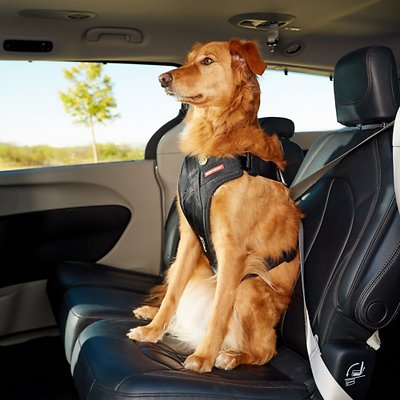
Most humans know that they have to buckle up by law when they get in their cars to drive anywhere. But did you know that it’s just as important for dogs and cats to be strapped in for their safety? Whether I’m driving to daycare or going to a vet appointment, my mom, Tonya, always buckles me and my dog siblings in her car to ensure our safety. However, not all humans know how to properly restrain their pets, so here are some facts and tips from an expert: me, The ORIGINAL Hipster Hound, Rex.
Car Accident Facts
According to a survey by the American Automobile Association, of the 43.3 million households in the US with pets, 84 percent of dog parents traveling with their dogs are NOT restraining them. The humans who ARE using some kind of restraint, only 16 percent of them are using proper safety restraints. SCARY!
Then, according to the National Highway Traffic Safety Administration (NHTSA), there were 5,687,000 crashes in 2013, with 1,591,000 injuries and 32,719 fatalities. There is a good chance there were pets in these vehicles since 34.4 million American households drive with their pets, and since over 80 percent of those pets were likely unrestrained, any pets in those accidents were most likely injured, or at the very minimum, in shock. If a dog survives a crash, they have been known to actually jump out of the vehicle and run away from the danger, thus becoming lost or injured further.
Even more horrifying: if a car crashes at a speed of just 25 mph, an unrestrained dog can be projected forward at a force equal to 40 times its weight. For example, a large-size dog weighing 75 pounds can achieve an impact force of 3,000 pounds in a car crash, which could be a lethal blow for both a passenger and the pet! Even for smaller pets traveling at just 30 miles per hour, an unrestrained 10 pound dog will exert 300 pounds of pressure in an accident. So without a crash tested safety restraint, even a pint-size pooch can injure passengers and become severely injured or killed on impact.
Proper Restraints Save Lives
So what CAN humans do to properly restrain their pets? Parents must keep in mind that not all restraints are created equal. Some may be fine for daily driving while others have been extensively evaluated by crash tests. At The Hipster Hound, we highly recommend crash-tested harnesses or crates as the BEST option for restraining dogs in the car. We also must stress that dogs should ALWAYS be restrained in the backseat of a car or in the cargo area of an SUV but NEVER in the front seat or on a lap while driving!
Something that The Hipster Hound wants to emphasize is that it is ILLEGAL for dogs to ride in the bed of a pickup truck! Humans can face a hefty fine and even jail time if they do this, so DO NOT put your dog in your truck bed! It is probably the most unsafe and irresponsible thing a pet parent can do!
At The Hipster Hound, we are HUGE fans of the Kurgo Quick Release Harness and Seatbelt. It comes in multiple sizes to ensure it fits your pup like a glove. The harness is made with high-quality materials and designed to be used with the included seatbelt tether. It’s so versatile, you don’t have to only use it in the car! The harness can be your dog’s everyday walking, jogging, or playing harness. It’s designed to be simple to use and alleviate the distraction a moving dog can cause in a vehicle.
Training Tips
Okay, so you’ve bought your dog a harness or crate, but he or she is looking at you like, “what do you expect me to do with this?” Looks like you may need to do a little training to get your dog comfortable and compliant with his or her new safety equipment!
- Put your dog in the harness or crate several days before actually using it in the car. This will help the dog get used to the equipment.
- Monitor your dog to make sure he or she isn't chewing on the restraint. Spraying the restraint with a chew deterrent before every use at the beginning will help to stop any problematic chewing.
- ALWAYS clip the restraint to a harness. NEVER clip a restraint to a head collar, training collar, or prong collar.
- Follow all instructions of your car harness with a seat belt clip or crate.
- Start any young puppy out right by using the proper safety restraints in the back seat or cargo area from day one.
Stop in at The Hipster Hound to ask any questions about pet car safety. Our experienced staff will be happy to help you navigate this possibly new idea of dog seat belts. Our pets are like family, so don’t you want to keep your family safe from harm?
Woof,
Rex, The Original Hipster Hound

Leave a comment